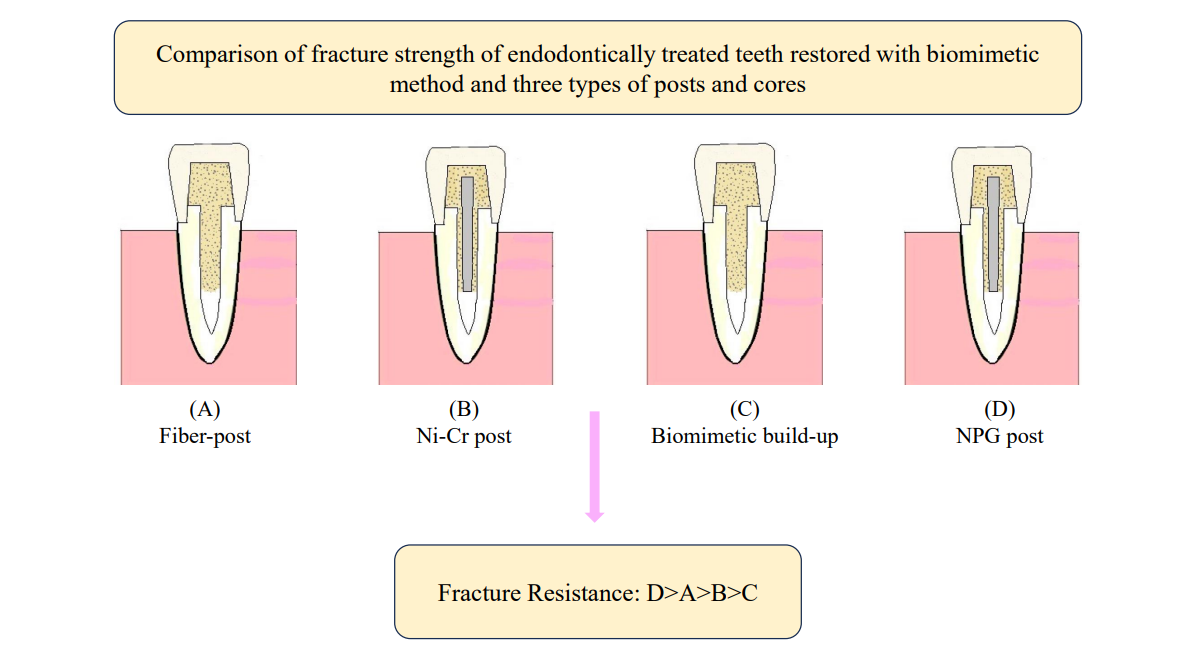Volume 35, Issue 247 (8-2025)
J Mazandaran Univ Med Sci 2025, 35(247): 108-116 |
Back to browse issues page
Download citation:
BibTeX | RIS | EndNote | Medlars | ProCite | Reference Manager | RefWorks
Send citation to:



BibTeX | RIS | EndNote | Medlars | ProCite | Reference Manager | RefWorks
Send citation to:
Rezaei K, Rezaei-Dastjerdi M, Mollaei M, Gholinia H, Hamedirad F. Comparison of the Fracture Strength of Endodontically Treated Teeth Restored with the Biomimetic Method and Three Types of Post-and-Core Systems. J Mazandaran Univ Med Sci 2025; 35 (247) :108-116
URL: http://jmums.mazums.ac.ir/article-1-21732-en.html
URL: http://jmums.mazums.ac.ir/article-1-21732-en.html
Abstract: (73 Views)
Background and purpose: In endodontically treated teeth, the use of post-cores and subsequent full-coverage crown restorations is a commonly proposed treatment modality. This study aimed to compare the fracture resistance of restored teeth using four different methods: biomimetic approach, fiber post, nickel-chromium (NiCr) cast post and core, and non-precious gold (NPG) cast post and core.
Materials and methods: In this experimental study, 40 maxillary single-rooted second premolars were selected and decoronated 2 mm above the cementoenamel junction (CEJ). Standard root canal treatments were performed, and the teeth were randomly divided into four groups. In the NiCr, NPG, and fiber post groups, metal crowns were fabricated and cemented using glass-ionomer cement. Biomimetic specimens were restored using indirectly applied modified resin-based fiber. A load at a 45 angle was applied to all specimens using a universal testing machine, and the fracture resistance of the teeth was measured. Fracture patterns were also assessed. Fracture data were analyzed using one-way analysis of variance (ANOVA), and pairwise comparisons were conducted using Tukey’s post hoc test. Failure patterns were analyzed using the Chi-square test.
Results: The highest fracture resistance values were observed in teeth restored using NPG posts (4622.37 N), followed by fiber posts (4534.22 N), NiCr posts (3794.45 N), and the biomimetic method (2329.58 N), respectively. The fracture resistance of teeth restored with NPG (P< 0.001), fiber (P< 0.001), and NiCr (P=0.025) posts was significantly higher than that of teeth restored using the biomimetic method. The highest incidence of unrestorable fractures was found in the fiber post group (80.0%), followed by NiCr (70.0%), NPG (50.0%), and the biomimetic method (50.0%).
Conclusion: Using the biomimetic method for restoring endodontically treated teeth resulted in lower fracture resistance than the studied post-core systems. However, the frequency of restorable fractures with this method was higher than that observed in the other methods.
Materials and methods: In this experimental study, 40 maxillary single-rooted second premolars were selected and decoronated 2 mm above the cementoenamel junction (CEJ). Standard root canal treatments were performed, and the teeth were randomly divided into four groups. In the NiCr, NPG, and fiber post groups, metal crowns were fabricated and cemented using glass-ionomer cement. Biomimetic specimens were restored using indirectly applied modified resin-based fiber. A load at a 45 angle was applied to all specimens using a universal testing machine, and the fracture resistance of the teeth was measured. Fracture patterns were also assessed. Fracture data were analyzed using one-way analysis of variance (ANOVA), and pairwise comparisons were conducted using Tukey’s post hoc test. Failure patterns were analyzed using the Chi-square test.
Results: The highest fracture resistance values were observed in teeth restored using NPG posts (4622.37 N), followed by fiber posts (4534.22 N), NiCr posts (3794.45 N), and the biomimetic method (2329.58 N), respectively. The fracture resistance of teeth restored with NPG (P< 0.001), fiber (P< 0.001), and NiCr (P=0.025) posts was significantly higher than that of teeth restored using the biomimetic method. The highest incidence of unrestorable fractures was found in the fiber post group (80.0%), followed by NiCr (70.0%), NPG (50.0%), and the biomimetic method (50.0%).
Conclusion: Using the biomimetic method for restoring endodontically treated teeth resulted in lower fracture resistance than the studied post-core systems. However, the frequency of restorable fractures with this method was higher than that observed in the other methods.
Type of Study: Brief Report |
Subject:
Dentistry
Send email to the article author
| Rights and permissions | |
 |
This work is licensed under a Creative Commons Attribution-NonCommercial 4.0 International License. |







